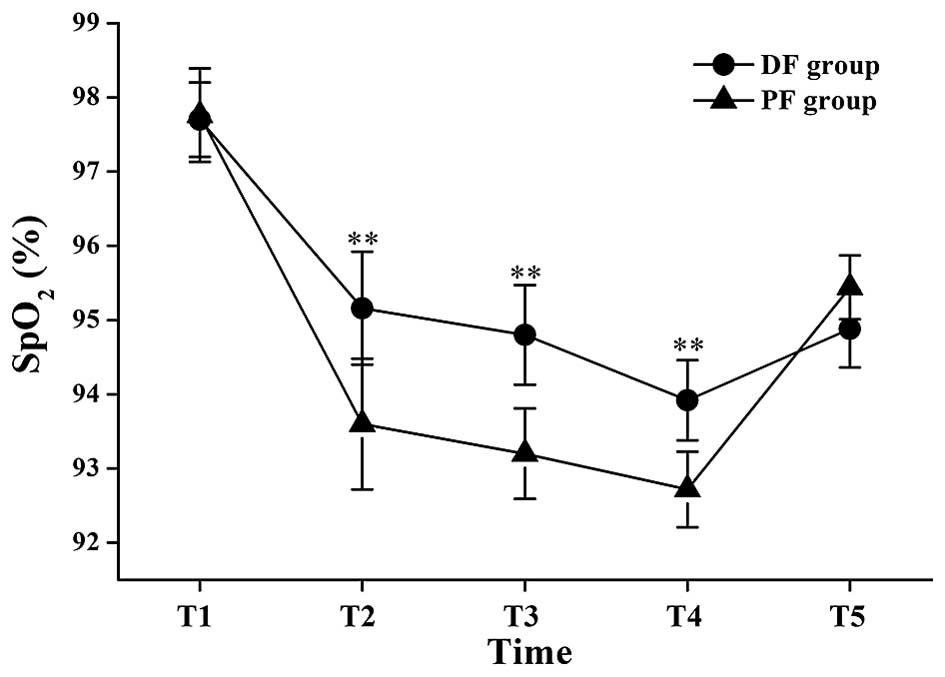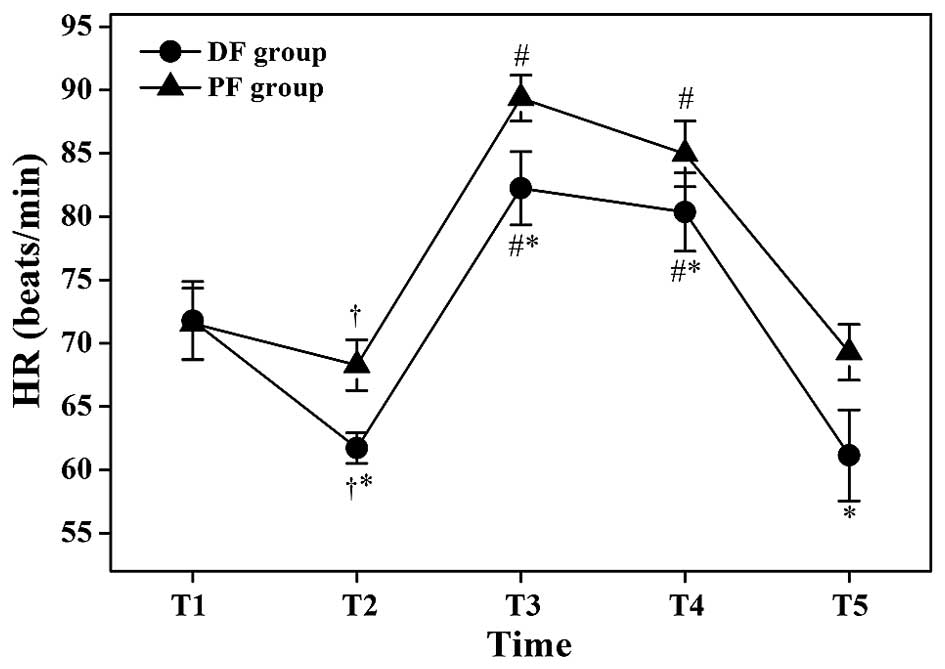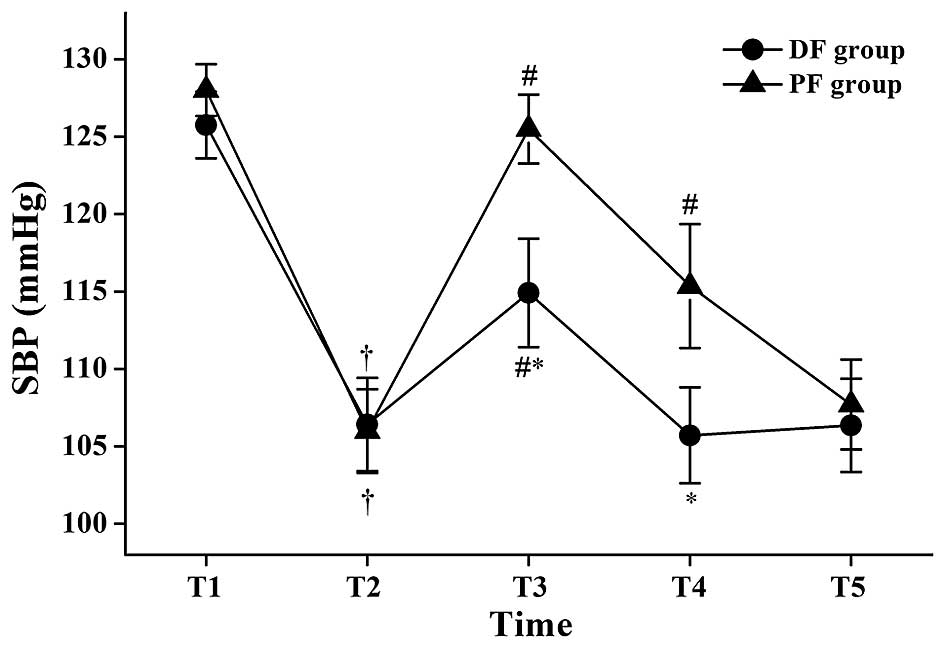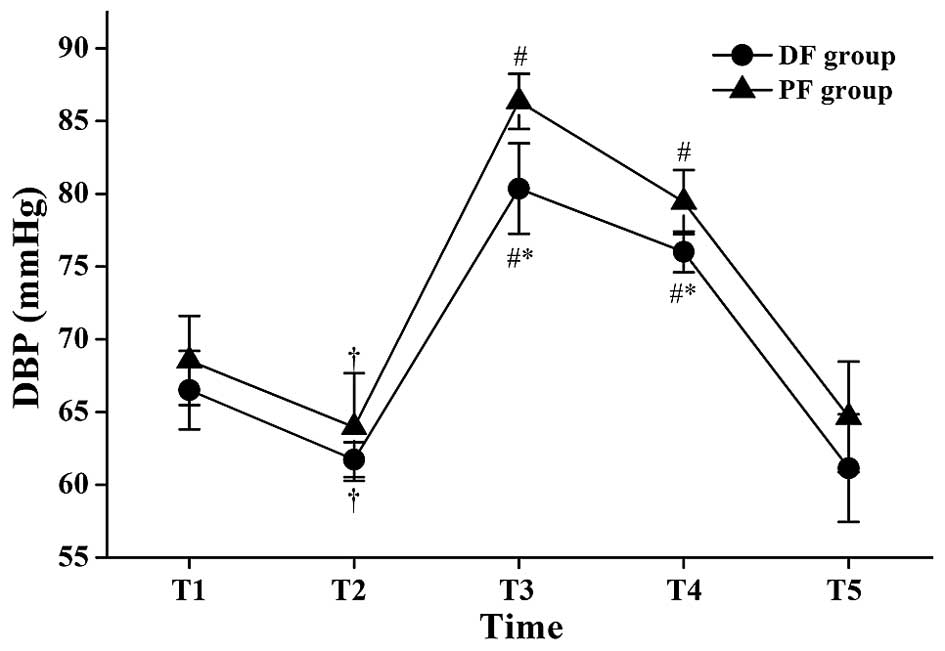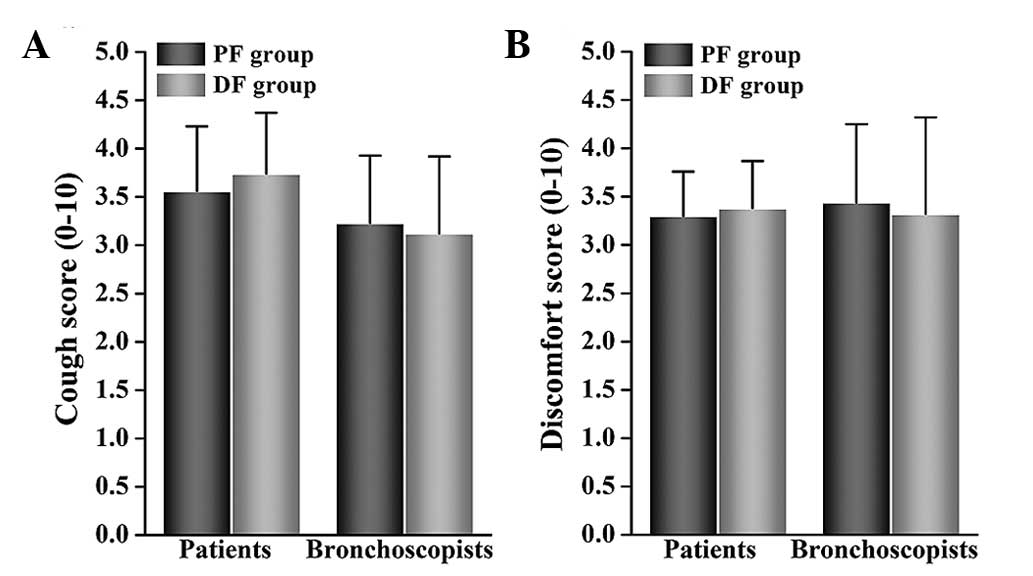|
1
|
Poi PJ, Chuah SY, Srinivas P and Liam CK:
Common fears of patients undergoing bronchoscopy. Eur Respir J.
11:1147–1149. 1998. View Article : Google Scholar : PubMed/NCBI
|
|
2
|
Xavier Scheuermeyer F, Andolfatto G, Qian
H and Grafstein E: Does the sedation regimen affect adverse events
during procedural sedation and analgesia in injection drug users?
CJEM. 15:279–288. 2013.PubMed/NCBI
|
|
3
|
Putinati S, Ballerin L, Corbetta L,
Trevisani L and Potena A: Patient satisfaction with conscious
sedation for bronchoscopy. Chest. 115:1437–1440. 1999. View Article : Google Scholar : PubMed/NCBI
|
|
4
|
Du Rand IA, Blaikley J, Booton R,
Chaudhuri N, Gupta V, Khalid S, Mandal S, Martin J, Mills J, Navani
N, et al: British Thoracic Society guideline for diagnostic
flexible bronchoscopy in adults. Thorax. 68(Suppl 1): i1–i44. 2013.
View Article : Google Scholar : PubMed/NCBI
|
|
5
|
Davies L, Mister R, Spence DP, Calverley
PM, Earis JE and Pearson MG: Cardiovascular consequences of
fibreoptic bronchoscopy. Eur Respir J. 10:695–698. 1997.PubMed/NCBI
|
|
6
|
Alletag MJ, Auerbach MA and Baum CR:
Ketamine, propofol and ketofol use for pediatric sedation. Pediatr
Emerg Care. 28:1391–1395. 2012. View Article : Google Scholar : PubMed/NCBI
|
|
7
|
Berkenbosch JW, Graff GR, Stark JM, Ner Z
and Tobias JD: Use of a remifentanil-propofol mixture for pediatric
flexible fiberoptic bronchoscopy sedation. Pediatric Anesthesia.
14:941–946. 2004. View Article : Google Scholar : PubMed/NCBI
|
|
8
|
Clark G, Licker M, Younossian AB, Soccal
PM, Frey JG, Rochat T, Diaper J, Bridevaux PO and Tschopp JM:
Titrated sedation with propofol or midazolam for flexible
bronchoscopy: A randomised trial. Eur Respir J. 34:1277–1283. 2009.
View Article : Google Scholar : PubMed/NCBI
|
|
9
|
Reyle-Hahn M, Niggemann B, Max M, Streich
R and Rossaint R: Remifentanil and propofol for sedation in
children and young adolescents undergoing diagnostic flexible
bronchoscopy. Paediatr Anaesth. 10:59–63. 2000. View Article : Google Scholar : PubMed/NCBI
|
|
10
|
Stolz D, Kurer G, Meyer A, Chhajed PN,
Pflimlin E, Strobel W and Tamm M: Propofol vs. combined sedation in
flexible bronchoscopy: A randomised non-inferiority trial. Eur
Respir J. 34:1024–1030. 2009. View Article : Google Scholar : PubMed/NCBI
|
|
11
|
Kodaka M, Okamoto Y, Handa F, Kawasaki J
and Miyao H: Relation between fentanyl dose and predicted
EC50 of propofol for laryngeal mask insertion. Br J
Anaesth. 92:238–241. 2004. View Article : Google Scholar : PubMed/NCBI
|
|
12
|
Peacock JE, Luntley JB, O'Connor B, Reilly
CS, Ogg TW, Watson BJ and Shaikh S: Remifentanil in combination
with propofol for spontaneous ventilation anaesthesia. Br J
Anaesth. 80:509–511. 1998. View Article : Google Scholar : PubMed/NCBI
|
|
13
|
Xu J, Yao Z, Li S and Chen L: A
non-tracheal intubation (tubeless) anesthetic technique with
spontaneous respiration for upper airway surgery. Clin Invest Med.
36:E151–E157. 2013.PubMed/NCBI
|
|
14
|
Hammer GB, Drover DR, Cao H, Jackson E,
Williams GD, Ramamoorthy C, Van Hare GF, Niksch A and Dubin AM: The
effects of dexmedetomidine on cardiac electrophysiology in
children. Anesth Analg. 106:79–83. 2008. View Article : Google Scholar : PubMed/NCBI
|
|
15
|
Tan JA and Ho KM: Use of dexmedetomidine
as a sedative and analgesic agent in critically ill adult patients:
A meta-analysis. Intensive Care Med. 36:926–939. 2010. View Article : Google Scholar : PubMed/NCBI
|
|
16
|
Bergese SD, Khabiri B, Roberts WD, Howie
MB, McSweeney TD and Gerhardt MA: Dexmedetomidine for conscious
sedation in difficult awake fiberoptic intubation cases. J Clin
Anesth. 19:141–144. 2007. View Article : Google Scholar : PubMed/NCBI
|
|
17
|
Ramsay MA and Luterman DL: Dexmedetomidine
as a total intravenous anesthetic agent. Anesthesiology.
101:787–790. 2004. View Article : Google Scholar : PubMed/NCBI
|
|
18
|
Stamenkovic DM and Hassid M:
Dexmedetomidine for fiberoptic intubation of a patient with severe
mental retardation and atlantoaxial instability. Acta Anaesthesiol
Scand. 50:1314–1315. 2006. View Article : Google Scholar : PubMed/NCBI
|
|
19
|
Muller S, Borowics SM, Fortis EA, Stefani
LC, Soares G, Maguilnik I, Breyer HP, Hidalgo MP and Caumo W:
Clinical efficacy of dexmedetomidine alone is less than propofol
for conscious sedation during ERCP. Gastrointest Endosc.
67:651–659. 2008. View Article : Google Scholar : PubMed/NCBI
|
|
20
|
Chhajed PN and Glanville AR: Management of
hypoxemia during flexible bronchoscopy. Clin Chest Med. 24:511–516.
2003. View Article : Google Scholar : PubMed/NCBI
|
|
21
|
Wahidi MM, Jain P, Jantz M, Lee P,
Mackensen GB, Barbour SY, Lamb C and Silvestri GA: American College
of Chest Physicians consensus statement on the use of topical
anesthesia, analgesia and sedation during flexible bronchoscopy in
adult patients. Chest. 140:1342–1350. 2011. View Article : Google Scholar : PubMed/NCBI
|
|
22
|
Panzer O, Moitra V and Sladen RN:
Pharmacology of sedative-analgesic agents: Dexmedetomidine,
remifentanil, ketamine, volatile anesthetics and the role of
peripheral mu antagonists. Crit Care Clin. 25:451–469. 2009.
View Article : Google Scholar : PubMed/NCBI
|
|
23
|
Gerlach AT and Dasta JF: Dexmedetomidine:
An updated review. Ann Pharmacother. 41:245–254. 2007. View Article : Google Scholar : PubMed/NCBI
|
|
24
|
Zhang X, He W, Wu X, Zhou X, Huang W and
Feng X: TCI remifentanil vs. TCI propofol for awake fiber-optic
intubation with limited topical anesthesia. Int J Clin Pharmacol
Ther. 50:10–16. 2012. View
Article : Google Scholar : PubMed/NCBI
|
|
25
|
Drake LM, Chen SC and Rex DK: Efficacy of
bispectral monitoring as an adjunct to nurse-administered propofol
sedation for colonoscopy: A randomized controlled trial. Am J
Gastroenterol. 101:2003–2007. 2006. View Article : Google Scholar : PubMed/NCBI
|
|
26
|
Grendelmeier P, Kurer G, Pflimlin E, Tamm
M and Stolz D: Feasibility and safety of propofol sedation in
flexible bronchoscopy. Swiss Med Wkly. 141:w132482011.PubMed/NCBI
|
|
27
|
Gasparini S: It is time for patients to
undergo bronchoscopy without discomfort. Eur Respir J. 38:507–509.
2011. View Article : Google Scholar : PubMed/NCBI
|
|
28
|
Jantz MA: The old and the new of sedation
for bronchoscopy. Chest. 135:4–6. 2009. View Article : Google Scholar : PubMed/NCBI
|
|
29
|
Ebert TJ, Hall JE, Barney JA, Uhrich TD
and Colinco MD: The effects of increasing plasma concentrations of
dexmedetomidine in humans. Anesthesiology. 93:382–394. 2000.
View Article : Google Scholar : PubMed/NCBI
|
|
30
|
Grant SA, Breslin DS, MacLeod DB, Gleason
D and Martin G: Dexmedetomidine infusion for sedation during
fiberoptic intubation: A report of three cases. J Clin Anesth.
16:124–126. 2004. View Article : Google Scholar : PubMed/NCBI
|
|
31
|
Deutsch E and Tobias JD: Hemodynamic and
respiratory changes following dexmedetomidine administration during
general anesthesia: Sevoflurane vs desflurane. Pediatr Anesth.
17:438–444. 2007. View Article : Google Scholar
|
|
32
|
Koroglu A, Teksan H, Sagir O, Yucel A,
Toprak HI and Ersoy OM: A comparison of the sedative, hemodynamic
and respiratory effects of dexmedetomidine and propofol in children
undergoing magnetic resonance imaging. Anesth Analg. 103:63–67.
2006. View Article : Google Scholar : PubMed/NCBI
|
|
33
|
Venn RM, Hell J and Grounds RM:
Respiratory effects of dexmedetomidine in the surgical patient
requiring intensive care. Crit Care. 4:302–308. 2000. View Article : Google Scholar : PubMed/NCBI
|
|
34
|
Liao W, Ma G, Su QG, Fang Y, Gu BC and Zou
XM: Dexmedetomidine vs. midazolam for conscious sedation in
postoperative patients undergoing flexible bronchoscopy: A
randomized study. J Int Med Res. 40:1371–1380. 2012. View Article : Google Scholar : PubMed/NCBI
|
|
35
|
Yoon HI, Kim JH, Lee JH, Park S, Lee CT,
Hwang JY, Nahm SF and Han S: Comparison of propofol and the
combination of propofol and alfentanil during bronchoscopy: A
randomized study. Acta Anaesthesiol Scand. 55:104–109. 2011.
View Article : Google Scholar : PubMed/NCBI
|
|
36
|
Adachi YU, Suzuki K, Obata Y, Doi M and
Sato S: Is the hemodynamic response to nasotracheal fiberoptic
bronchoscopy less than that following orotracheal bronchoscopy?
Anesth Analg. 105:5432007. View Article : Google Scholar : PubMed/NCBI
|
|
37
|
Ryu JH, Lee SW, Lee JH, Lee EH, Do SH and
Kim CS: Randomized double-blind study of remifentanil and
dexmedetomidine for flexible bronchoscopy. Br J Anaesth.
108:503–511. 2012. View Article : Google Scholar : PubMed/NCBI
|
|
38
|
He XY, Cao JP, Shi XY and Zhang H:
Dexmedetomidine vs. morphine or fentanyl in the management of
children after tonsillectomy and adenoidectomy: A meta-analysis of
randomized controlled trials. Ann Otol Rhinoly Laryngol.
122:114–120. 2013. View Article : Google Scholar
|
|
39
|
Hendrickx JF, Eger EI II, Sonner JM and
Shafer SL: Is synergy the rule? A review of anesthetic interactions
producing hypnosis and immobility. Anesth Analg. 107:494–506. 2008.
View Article : Google Scholar : PubMed/NCBI
|
|
40
|
Piao G and Wu J: Systematic assessment of
dexmedetomidine as an anesthetic agent: A meta-analysis of
randomized controlled trials. Arch Med Sci. 10:19–24. 2014.
View Article : Google Scholar : PubMed/NCBI
|















